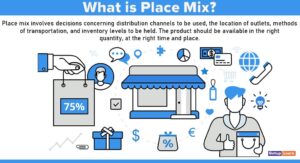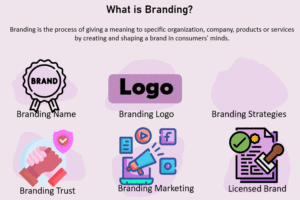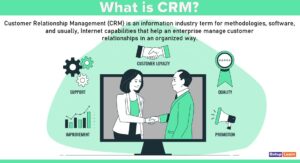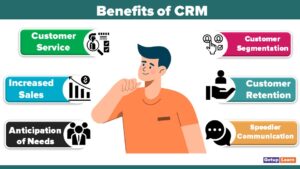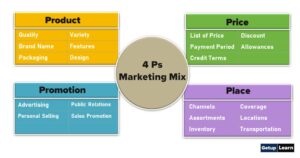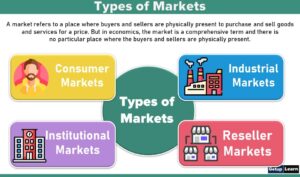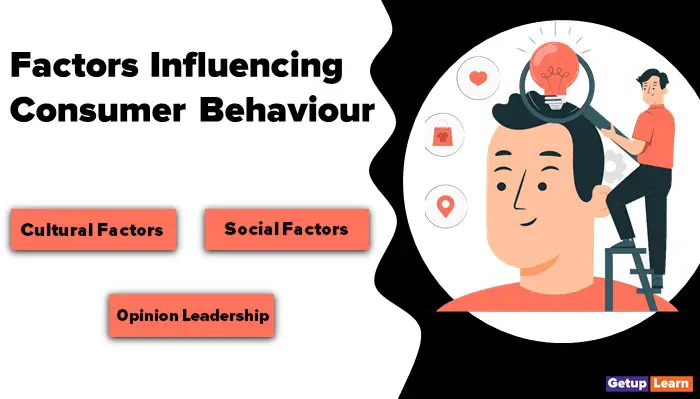
Table of Contents
Factors Influencing Consumer Behaviour
These are the factors influencing consumer behaviour explained below:
- Cultural Factors Influencing Consumer Behaviour
- Social Factors Affecting Consumer Behaviour
- Opinion Leadership in Consumer Behaviour
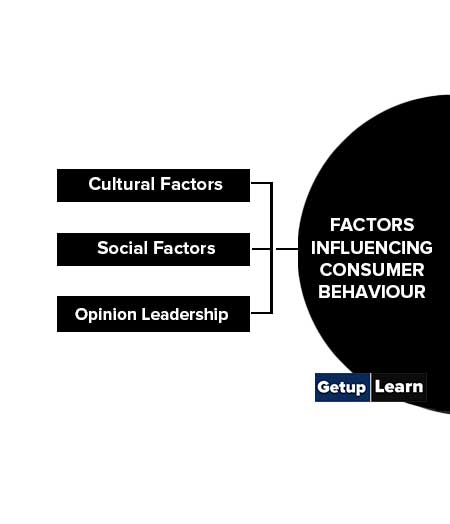
Cultural Factors Influencing Consumer Behaviour
Following are the cultural factors influencing consumer behaviour:
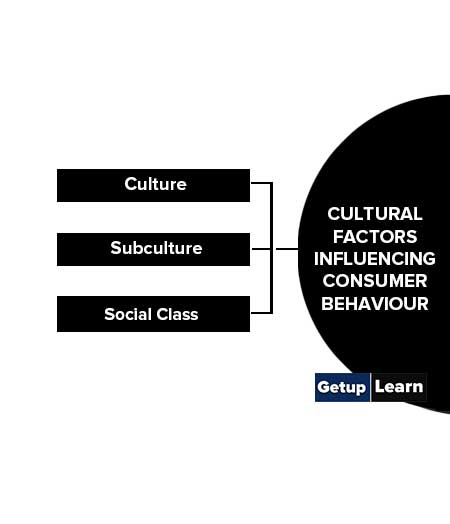
Culture
Culture is an important characteristic of a society that distinguishes it from other societal groups. Culture influences the behaviour of the can be seen in that transmits from one generation to another. Cultural diversity operates in dress, food habits, marriage practices and almost all matters of the individual’s life. It manifests through various symbols and rituals which are unique to the society.
Subculture
The Culture includes smaller groups of a subculture which are formed on the basis of demographic characteristics, geographic regions, national and ethnic background, political beliefs and regional beliefs. A subculture is a homogeneous group of people who shares the elements of the overall culture as well as cultural elements unique to their own group.
Social Class
Social Class of people, who are equal in status. These people socialize among themselves both formally and informally and share behavioural norms. Social class is determined by occupation, income, education etc.
Following are the social factors affecting consumer behaviour:
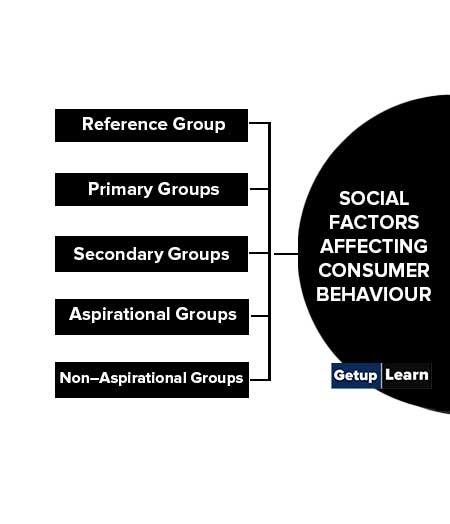
Reference Group
A person’s reference group are all the group that has a direct (face to face) or indirect influence on their attitude or behaviour. “Reference Group is a group that serves as a reference point for an individual in the formation of his/her beliefs, attitudes and behaviour.
Reference groups are basically small in size and differ from one individual to another. Family members, relatives, friends, colleagues and other close acquaintances are usually termed, reference groups. Marketers frequently advertise their products in a group setting the family eating breakfast cereals, the neighbour admiring the paint of the house.
Primary Groups
Primary groups are basically ones whose members are closely knit. Family and relatives fall into this group. These people from primary groups may have a direct and strong impact on your lives and your buying decisions since they are very significant to you.
Primary groups make you comfortable and give you a feeling that they are with you when you are confused about a purchase. These people give you very honest and clear advice as they are so close to you, due to which you could be more confident about the purchase.
Secondary Groups
Secondary reference groups are usually formal and they speak less frequently. They may be members of clubs where the meeting may happen only once in a while. In secondary reference groups, the power to influence people is quite less as compared to primary reference groups as people in these groups are not that comfortable in sharing their thoughts or views on the purchase.
Aspirational Groups
An aspirational group is one of which a person may want to become part. They currently are not part of that group but wish to become and get with that group. By doing the same, they try to dress, talk, act and even think the way the members of that group do.
For example, people who like Madhuri Dixit wish to become like her and meet her and so start purchasing and using all those products that she endorses.
Non–Aspirational Groups
The people in these groups are totally opposite to the people in the aspirational group. Here people deny becoming or getting connected to a particular group. They just hate being related to that group.
For example, if people don’t like a particular community, they would never like to be connected to them. So they would try all the possible ways to avoid the way in which they dress, think or act.
Opinion Leadership in Consumer Behaviour
Following are the opinion leadership in consumer behaviour:
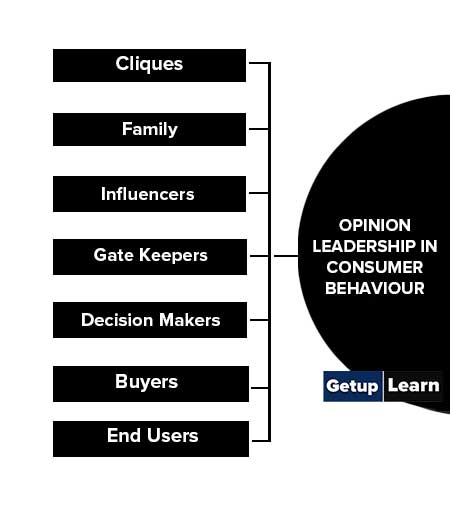
An opinion leader is a person who offers informal advice or information about a specific product or product category, such as which brand is best or how a particular product may be used.
Cliques
Are small groups, whose members interact frequently. They are similar and their closeness facilitates effective communication but also insulates the clique from new ideas. The challenge is to create more openness so cliques exchange information with others in society.
This openness is helped by people who function as liaisons and connect two or more cliques without belonging to either and by bridges, people who belong to one clique and are linked to a person in another.
Family
Family members are the most influencing factor in consumer buying behaviour. In a family parents and siblings are considered most influential. E.g.: A family that strongly values good health will have a grocery list distinctly different from that of a family that views every dinner as a gourmet event.
Moreover, the family is responsible for the socialization process, and the passing down of cultural values and norms to children. Children learn by observing their parents’ consumption patterns, and so they will tend to shop in a similar pattern.
Influencers
Influencers are the ones who give ideas or information about the product or service to the consumer.
Gate Keepers
Gatekeepers are the family members who usually panel the information. They can be our parents or siblings too who can in any form provide us with information about the product.
Decision Makers
Family or our parents who usually have the power to take decisions on our behalf are the decision makers. After completing the research they may decide to purchase the particular or dispose of it.
Buyers
The buyer is the one who actually makes the purchase of the product.
End Users
The person who finally uses the product or consumes the service is the ultimate consumer also called as an End user as per the context.
Personal Factors Affecting Consumer Behaviour
Following are the personal factors affecting consumer behaviour:
- Gender
- Age and Life Cycle
- Occupation
- Personality
- Lifestyle
- Psychological Factors
- Perception
- Motivation
- Physiological Needs
- Safety Needs
- Social Needs
- Esteem Needs
- Self-Actualization
- Learning
- Emotions
- Belief
- Attitude

Gender
There is a physiological difference between men and women and because of this, they have different needs.
For Example Health and beauty products. Men and Women play a distinct cultural, economic and social roles in society and this has an effect on their decision–making process also.
Age and Life Cycle
At all stages in life, people buy or prefer goods and services. Depending on the age of a consumer, is a general indication of what product he or she may be interested in purchasing. Consumer tastes in food, clothing, car, furniture and recreation are often age-related.
A bachelor would prefer spending lavishly on items like beer, bikes, music, clothes, parties, clubs and so on. A young single would hardly be interested in buying a house, property, insurance policies, gold etc.
An individual who has a family, on the other hand, would be more interested in buying something which would benefit his family and make their future secure.
Occupation
According to occupation, the preference changes. Occupation affects the person’s choice in the selection of products and services.
Blue-collar workers tend to buy more rugged work clothes; whereas white-collar executives buy more business suits. A company can even specialize in making products needed by a given occupational group.
Personality
Personality is defined in terms of traits like self–confidence, dominance, autonomy, deference, sociability, defensiveness and adaptability. Brands also have personalities and consumers are likely to choose a brand which matches their personality consistent with their actual self-concept.
Lifestyle
Life means a person’s pattern of living. Though people came from the same culture, subculture, social class or occupation but their patterns of living may be different. Lifestyle can be expressed in terms of a person’s activities, interests and opinions.
For example when a consumer leads a healthy lifestyle, then the products he buys will relate to healthy nourishments.
Psychological Factors
An individual’s buying decisions are further influenced by psychological factors: Perception, motivation, learning, belief and attitude.
Perception
A stimulus is any unit of input affecting one or more of the five senses: sight, smell, taste, touch, and hearing. The process by which we select, organize and interpret these stimuli into a meaningful and coherent picture is called perception.
In essence, perception is how we see the world around us and how we recognize that we need some help in making a purchasing decision.
Motivation
When you buy a product, you usually want to fulfil some kind of need. These needs become a motive when aroused sufficiently.
Example: Suppose you are hungry and you stop to have Vadapav. In this case, you are motivated by hunger to stop at the Vadapav shop. Motives are the driving force that causes a person to take action to satisfy specific needs.
Maslow’s hierarchy of needs has arranged needs in ascending order of importance physiological, safety, social, esteem, self–actualization needs.
Physiological Needs
Are basic needs like hunger, thirst, and shelter. Advertisements showing pizza and juice after a marathon are examples of appeals to satisfy hunger and thirst.
Safety Needs
Includes security and freedom from pain and discomfort. Example Aware of the ageing population’s health fears, their medical centre advertises that they offer consumers a full body scan for early detection of chronic diseases.
includes a sense of belonging, and love. Advertisements for clothes, cosmetics and vacation packages suggest that buying the product can bring affection.
Esteem Needs
Include self-respect and a sense of accomplishment, prestige, fame and recognition. Esteem needs are the basis for the human desire we all have to be accepted and valued by others. Mont Blanc pens and Mercedes-Benz automobile stores all appeal to esteem needs.
Self-Actualization
Self-actualization needs are the highest levels in Maslow’s hierarchy, and refer to the realization of a person’s potential, self–fulfilment, seeking personal growth and peak experiences. Even so, advertisements may focus on this type of need.
For Example, Microsoft appealed to consumers’ needs for self–actualization when it chose “Your Potential our passion” as the windows XP slogan.
Learning
Consumer behaviour is the result of learning, which is the process that creates changes in behaviour through experience and practice. It is not possible to observe learning directly, but we can infer when it has occurred by a person’s action.
For example, suppose you see an advertisement for new improved headache medicine, and you go to the store that day and buy that medicine. We infer that you have learned something about medicine.
Emotions
Companies develop advertisements that are emotional and invoke a different kind of feelings. Consumer response is not always cognitive or rational. Cadbury’s advertisements are very emotional and touch one’s heart.
An emotion-filled brand story has been shown to trigger’s people desire to pass along things they hear about brands, through either word of mouth or online sharing.
Belief
Belief is an organized pattern of knowledge that an individual holds as true about his or her world. A consumer may believe that the Apple i-phone is durable, the touch screen is smooth and is reasonably priced according to its features.
This belief is based on the knowledge and faith the consumer has in the product. The consumer tends to develop a belief about the product attributes and then, through these beliefs, form a brand image a set of beliefs about a particular brand. In turn, the brand images shape consumers’ attitudes towards the product.
Attitude
An Attitude is a learned tendency to respond consistently towards a given object, such as a brand. Attitudes rest on the individual value system, which represents personal standards of good and bad, right and wrong, therefore, attitudes tend to be more enduring and complex than beliefs.
For example, Attitude toward using credit cards for purchases across the world.
What are the 5 factors influencing consumer Behaviour?
Factors influencing consumer behaviour are:
1. Culture
2. Social Factors
3. Reference Group
4. Opinion Leadership
5. Personal Factors.
What are cultural factors influencing consumer Behaviour?
Cultural factors influencing consumer behaviour are:
1. Culture
2. Subculture
3. Social Class.
Social factors affecting consumer behaviour are:
1. Reference Group
2. Primary Groups
3. Secondary Groups
4. Aspirational Groups
5. Non–Aspirational Groups.
What is opinion leadership in consumer Behaviour?
Opinion leadership in consumer behaviour are:
1. Cliques
2. Family
3. Influencers
4. Gate Keepers
5. Decision Makers
6. Buyers
7. End Users.
What are the personal factors affecting consumer behaviour?
Personal factors affecting consumer behaviour are:
1. Gender
2. Age and Life Cycle
3. Occupation
4. Personality
5. Lifestyle
6. Psychological Factors
7. Perception
8. Motivation
9. Physiological Needs
10. Safety Needs.


